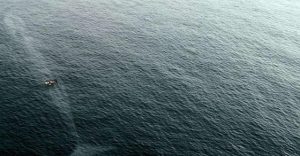 The fantastic in “Salt Slow” is not the many sea creatures that appear dead on the surface of the water; it is the size of the sea creatures. There is not one specific element of the fantastic in this story; a few others are the “baby” born, the webbed fingers that grow as the creatures grow, and the abandoned boats/settlements. “Her feet are growing webbed, although they don’t talk about that. Sometimes at night he takes his apple knife to the delicate membranes between her toes, but they don’t talk about that, either.” “Salt slow” shows the distance between people, the couple the story follows, and the distance between their current lives and their past ones. The flooding is a reference to the biblical flood, or at least similar to it. The people left are few and far between, however, the only animals we see as readers is the mythical sized from the boat. We only hear about animals we know as dead or food. Everything in this story has changed except the couple, and even then the flashbacks show the difference in what they had before the flood and after the tide started. Their relationship went from one of passion to one not necessarily of necessity, but one of mutual understanding. “WHEN THEY HAD first fallen in love, she had kissed him with an intensity which imagined him already halfway out the door.” I think this is not only a story of the fantastic, but it is also a type of horror story. These creatures and life on the ocean is the true horror. Her body is transforming to be more sea creatures like, and the “child” she gives birth to is not human. This is a physical transformation, unlike “Metamorphosis,” that was how Gregor felt in his situation. In “Salt Slow,” the change is literal. She is becoming like the creatures below.
The fantastic in “Salt Slow” is not the many sea creatures that appear dead on the surface of the water; it is the size of the sea creatures. There is not one specific element of the fantastic in this story; a few others are the “baby” born, the webbed fingers that grow as the creatures grow, and the abandoned boats/settlements. “Her feet are growing webbed, although they don’t talk about that. Sometimes at night he takes his apple knife to the delicate membranes between her toes, but they don’t talk about that, either.” “Salt slow” shows the distance between people, the couple the story follows, and the distance between their current lives and their past ones. The flooding is a reference to the biblical flood, or at least similar to it. The people left are few and far between, however, the only animals we see as readers is the mythical sized from the boat. We only hear about animals we know as dead or food. Everything in this story has changed except the couple, and even then the flashbacks show the difference in what they had before the flood and after the tide started. Their relationship went from one of passion to one not necessarily of necessity, but one of mutual understanding. “WHEN THEY HAD first fallen in love, she had kissed him with an intensity which imagined him already halfway out the door.” I think this is not only a story of the fantastic, but it is also a type of horror story. These creatures and life on the ocean is the true horror. Her body is transforming to be more sea creatures like, and the “child” she gives birth to is not human. This is a physical transformation, unlike “Metamorphosis,” that was how Gregor felt in his situation. In “Salt Slow,” the change is literal. She is becoming like the creatures below.
Horror in “Salt Slow”
Mar 5th, 2020 by peterson20